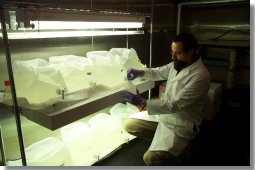IVARS Science at McMurdo
The IVARS project involves two short cruises per year: one in mid- to late-December (during the "spring bloom" of phytoplankton in the Ross Sea), and one in mid-February (at the end of the phytoplankton growing season).
Between the December and February cruises, most of the IVARS science team returns to the U.S. But for the last few years,
Walker Smith's graduate students Amy Shields and Sasha Tozzi have spent the weeks between cruises conducting lab experiments in
McMurdo's Crary Science and Engineering Center, the Station's
main research building.
Setting up shop at McMurdo frees Amy and Sasha from having to ship their heavy water samples half way around the globe, and gives them access to a laboratory facility unavailable at VIMS: a large environmental chamber that can be held at 28° Fahrenheit (-2° Celsius). That's the normal temperature of water in the Ross Sea, which helps explains the lack of local swimming beaches. Working at McMurdo also allows them to collect additional water samples of similar temperature and salinity (from McMurdo Sound) when their experiments require it.
Amy and Sasha are conducting the McMurdo experiments as part of their Ph.D. dissertations, and to help answer specific components of the overall research questions posed by the IVARS project. Sasha is most interested in the differing role that iron may play in photosynthesis within single-celled plants called diatoms and in Phaeocystis antarctica, a colonial phytoplankton species. Both organisms play a key role in the ecosystem of the Ross Sea and McMurdo Sound. Amy is studying various aspects of P. antarctica's ecology and life cycle, including the physiological factors that cause it to form colonies, and the ecological factors that influence its relationship with predators (more on this later).
Iron's role in photosynthesis is a hot topic in biological oceanography. That's because sprinkling iron onto the ocean surface has been touted as one way to help curb global warming—based on the idea that this iron "fertilizer" can boost the rate at which marine plants remove carbon dioxide from the atmosphere and ocean surface during photosynthesis. Because carbon dioxide is the main greenhouse gas, any reduction in its atmospheric concentration would help to curb global warming.
Previous field experiments have validated the "iron hypothesis" by adding iron to areas of polar sea lacking in this element and watching the fertilized patches bloom. These experiments show that diatoms are the group likely to grow the fastest when iron is added to polar waters, even though they are relatively uncommon there.
Sasha's lab experiment at McMurdo turns these earlier experiments on their heads. Rather than adding iron, he uses a chemical called DFOB that binds waterborne iron into a form that plants can't use. He adds the chemical to large jugs of Ross Sea seawater that were collected at IVARS sampling stations exhibiting different percentages of diatoms and P. antarctica. He leaves other control jugs alone. All the jugs are kept in an environmental chamber under constant light and at 28° to mimic Ross Sea conditions during summer.
Sasha then compares how the two types of phytoplankton respond in the control and experimental jugs. His hypothesis is that Antarctic diatoms have a higher iron requirement then P. antarctica. A higher iron concentration in the diatom cells would give these organisms the ability to adapt more rapidly to changes in light intensity and to use high light intensity more efficiently, thus helping to explain their positive response to the iron-enrichment experiments. P. antarctica's lesser need for iron would allow this species to prosper at the expense of diatoms during periods of low iron availability, such as occurs in the late summer in the open polynya.
Changes in the relative proportions of diatoms and P. antarctica within Ross Sea plankton blooms can significantly affect the local ecosystem as well as large-scale biogeochemical cycles. Unlike P. antarctica, diatoms make external "skeletons" of silica, and are heavy enough so that they sink when they die, thus carrying carbon out of the surface ocean and atmosphere. Diatoms are also thought to be more palatable to zooplankton. Some of these zooplankton grazers can package the diatom tissues they eat into relatively heavy fecal pellets that also sink rapidly and carry carbon to the depths. Every particle of carbon in deep-ocean sediments is one less particle in the atmospheric greenhouse.
The final test of Sasha's hypothesis awaits the results of data analysis back at VIMS. But in the meantime, Sasha and the rest of the IVARS crew need to get ready for tomorrow, when we are scheduled to board the R/V Nathaniel B. Palmer to begin our cruise.

